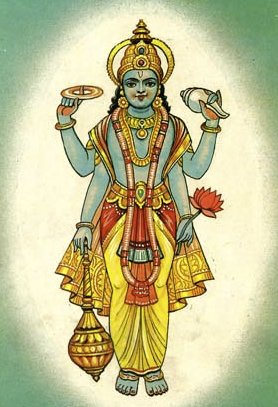Prasannatman, Prasannātman, Prasanna-atma, Prasannatma, Prasanna-atman, Prasannātmā: 7 definitions
Introduction:
Prasannatman means something in Hinduism, Sanskrit. If you want to know the exact meaning, history, etymology or English translation of this term then check out the descriptions on this page. Add your comment or reference to a book if you want to contribute to this summary article.
In Hinduism
Vaishnavism (Vaishava dharma)
Source: Pure Bhakti: Bhagavad-gita (4th edition)Prasannātmā (प्रसन्नात्मा) refers to “joyful soul; the first characteristic of one situated in brahma-bhūta, having transcended the gross and subtle bodies manipulated by the three modes of material nature”. (cf. Glossary page from Śrīmad-Bhagavad-Gītā).

Vaishnava (वैष्णव, vaiṣṇava) or vaishnavism (vaiṣṇavism) represents a tradition of Hinduism worshipping Vishnu as the supreme Lord. Similar to the Shaktism and Shaivism traditions, Vaishnavism also developed as an individual movement, famous for its exposition of the dashavatara (‘ten avatars of Vishnu’).
Purana and Itihasa (epic history)
Source: archive.org: Shiva Purana - English TranslationPrasannātmā (प्रसन्नात्मा) refers to “one who becomes delighted”, according to the Śivapurāṇa 2.3.13 (“Śiva-Pārvatī dialogue”).—Accordingly, after Pārvatī spoke to Śiva: “On hearing these words of Pārvatī, the great lord engaged in the causation of great enjoyment and protection became delighted [i.e., prasannātmā]. He laughed and said”.

The Purana (पुराण, purāṇas) refers to Sanskrit literature preserving ancient India’s vast cultural history, including historical legends, religious ceremonies, various arts and sciences. The eighteen mahapuranas total over 400,000 shlokas (metrical couplets) and date to at least several centuries BCE.
Shaivism (Shaiva philosophy)
Source: SOAS University of London: Protective Rites in the Netra TantraPrasannātmā (प्रसन्नात्मा) refers to “pure-souled”, according to the Netratantra of Kṣemarāja: a Śaiva text from the 9th century in which Śiva (Bhairava) teaches Pārvatī topics such as metaphysics, cosmology, and soteriology.—Accordingly, [verse 2.17-19]—“The pure-souled Ācārya (prasannātmā—ācāryas tu prasannātmā) should draw an eight petaled lotus, in smooth, pure earth [that is] smeared with sandal and aloe wood [and] scented [with] fragrant camphor and strong saffron. After he has drawn [the lotus] with a great undertaking, [the Ācarya,] decorated and adorned with a crown, smeared with sandalwood, [writes] the mātṛkā. Having placed oṃ in the middle [on the pericarp of the lotus], he should draw [the phonemes of the mātṛkā on the petals] starting in the East”.

Shaiva (शैव, śaiva) or Shaivism (śaivism) represents a tradition of Hinduism worshiping Shiva as the supreme being. Closely related to Shaktism, Shaiva literature includes a range of scriptures, including Tantras, while the root of this tradition may be traced back to the ancient Vedas.
Languages of India and abroad
Sanskrit dictionary
Source: DDSA: The practical Sanskrit-English dictionaryPrasannātman (प्रसन्नात्मन्).—a. gracious-minded, propitious. (-m.) Name of Viṣṇu.
Prasannātman is a Sanskrit compound consisting of the terms prasanna and ātman (आत्मन्).
Source: Cologne Digital Sanskrit Dictionaries: Shabda-Sagara Sanskrit-English DictionaryPrasannātman (प्रसन्नात्मन्).—Adj. Propitious.
Source: Cologne Digital Sanskrit Dictionaries: Cappeller Sanskrit-English DictionaryPrasannātman (प्रसन्नात्मन्).—[adjective] of gracious or tranquil mind.
Source: Cologne Digital Sanskrit Dictionaries: Monier-Williams Sanskrit-English DictionaryPrasannātman (प्रसन्नात्मन्):—[=pra-sannātman] [from pra-sanna > pra-sad] mfn. gracious-minded, propitious, [Maitrī-upaniṣad]
Sanskrit, also spelled संस्कृतम् (saṃskṛtam), is an ancient language of India commonly seen as the grandmother of the Indo-European language family (even English!). Closely allied with Prakrit and Pali, Sanskrit is more exhaustive in both grammar and terms and has the most extensive collection of literature in the world, greatly surpassing its sister-languages Greek and Latin.
See also (Relevant definitions)
Relevant text
Search found 9 books and stories containing Prasannatman, Prasannātman, Prasanna-ātman, Prasanna-atma, Prasannatma, Prasanna-atman, Prasannātmā, Pra-sannatman, Pra-sannātman, Prasanna-ātmā; (plurals include: Prasannatmans, Prasannātmans, ātmans, atmas, Prasannatmas, atmans, Prasannātmās, sannatmans, sannātmans, ātmās). You can also click to the full overview containing English textual excerpts. Below are direct links for the most relevant articles:
Shrimad Bhagavad-gita (by Narayana Gosvami)
Verse 18.54 < [Chapter 18 - Mokṣa-yoga (the Yoga of Liberation)]
Verse 13.31 < [Chapter 13 - Prakṛti-puruṣa-vibhāga-yoga]
Verse 13.13 < [Chapter 13 - Prakṛti-puruṣa-vibhāga-yoga]
Rudra-Shiva concept (Study) (by Maumita Bhattacharjee)
33. Ṛṣabha incarnation < [Chapter 5 - Rudra-Śiva in the Purāṇic Literature]
5. Protective or benevolent activities of Śiva < [Chapter 5 - Rudra-Śiva in the Purāṇic Literature]
3. The God Rudra-Śiva: His Prominence < [Chapter 1 - Introduction]
Garga Samhita (English) (by Danavir Goswami)
Verse 2.13.22 < [Chapter 13 - The Story of Śeṣa]
Verses 2.18.31-32 < [Chapter 18 - The Sight of Śrī Kṛṣṇacandra]
Prasthanatrayi Swaminarayan Bhashyam (Study) (by Sadhu Gyanananddas)
3.8.2. Purpose of the Creation < [Chapter 3 - Analysis on the Basis of Metaphysics]
1.1. Three Bodies and Three States of the Jīva < [Chapter 3 - Analysis on the Basis of Metaphysics]
Chaitanya Bhagavata (by Bhumipati Dāsa)
Verse 2.17.107 < [Chapter 17 - The Lord’s Wandering Throughout Navadvīpa and Descriptions of the Devotees’ Glories]
The Gita’s Ethics (A Critical Study) (by Arpita Chakraborty)
8. Moksa (unity with the Supreme self) < [Chapter 4 - Moral Action and Emancipation]